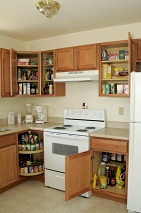Eating Nutritious Foods Starts With Getting Organized

When your desk is in order and schedule is up-to-date, your work is likely more effective, efficient and of higher quality. The same goes for your diet. When your meals and snacks are organized, it’s easier to make nutritious choices. Here’s how to organize three main components of your life in order to make healthful eating easier.
Your schedule: Although it might sound funny to schedule your meals and snacks, it’s a wise move. It’s all too easy to run out the door without breakfast. Or, to run to your child’s soccer game after work, only to discover that after two overtimes, your dinner is going to be pretty late. Look at your scheduled events for the week and schedule your meals and snacks just like any other event. After all, it’s your meals and snacks that fuel you so you have the energy to make it to your other obligations. Plus, scheduling in regular meals and snacks helps prevent large gaps of time (more than four or five hours) without food – which can make it a lot easier to stick with healthful choices and moderate portions.
(See Shopping for the Pantry.)
Your kitchen: An organized, clean kitchen (including the fridge, cabinets and pantry) is usually the difference between learning to love cooking at home… and dreading it. From the time you open the refrigerator or gather spices, to the time you reach for kitchen gadgets or utensils, having what you need at the ready makes the process of creating meals and snacks a lot easier. In order to maximize your kitchen space, start by getting rid of any appliances (or other items that take up counter, drawer or shelf space). Then do the same for food – whether it’s old condiments in the fridge or ancient spices on shelves.
And last, but not least, keep your kitchen stocked with healthful choices – a bowl of fruit on the counter, plenty of whole grains/whole grain products in the pantry, veggies, lean protein, and low-fat dairy in the fridge, etc. For even more details on kitchen organization, visit our previous blog Kitchen Makeover.
(See Menu Planning Makes Family Dinners Easier)
Your meals: Your plate might seem like an easy task compared to your kitchen – but it can make a big difference in eating well and sticking with nutritious eating. First off, invest in smaller plates. Consider using a salad plate as your primary plate. Salad plates are around eight inches in diameter, an ideal size to serve as a template for a balanced (and calorie-appropriate) meal.
At each meal, aim to organize your plate into two halves, filling one half with veggies and then dividing the other half into two sections. In one of the remaining sections put lean protein (like salmon, tuna, grilled chicken, the “loin” cut of meat, salmon, etc.) and place whole grains (whole grain roll, crackers, cooked whole grains, etc.) in the final section. Now you’ve got a balanced meal – no weighing required. For breakfast, aim for one serving of low-fat/nonfat dairy, 1-2 servings of whole grains, one serving of fruit, and 1-2 servings of nutritional fat. Your breakfast should weigh in around 350 calories.
For more articles about healthy eating, visit BeeWell for Life BeeDelicious.
How has organization helped you and your family live a more balanced lifestyle?
This post was originally published on the BeeWell for Life blog. BeeWell for Life is a health and wellness community created by Bumble Bee Foods to promote healthy lifestyles and raise donations to fight diabetes, heart disease and breast cancer.

